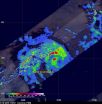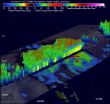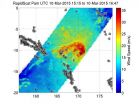TRMM sees large and more powerful Cyclone Pam, warnings posted
2015-03-11
(Press-News.org) The Tropical Rainfall Measuring Mission or TRMM satellite saw powerful towering thunderstorms in Tropical Cyclone Pam, indicating the storm was strengthening as it moved through the Solomon Islands. Pam has now triggered warnings in the Solomon Islands, Vanuatu and New Zealand.
In the Solomon Islands, a tropical cyclone warning was in effect today, March 11, for Temotu, Malaita and Makira provinces. A tropical cyclone watch was in effect for Rennell and Bellona, Central, Isabel, Western, Guadalcanal and the Choiseul provinces.
In Vanuatu, a tropical cyclone warning is in effect for the provinces of Torba, Penama, Sanma and Malampa. In the next day to day and a half, the Shefa and Tafea provinces will feel the effects of Pam.
Additional warnings are also in effect in New Zealand as Pam continues to head south. Parts of the North Island are likely to be affected by severe weather on Monday, March 16. The areas cited under the warning are Gisborne and northern Hawkes Bay.
The TRMM satellite had a good look at Cyclone Pam on March 10, 2015 at 1127 UTC 7:27 a.m. EDT) when maximum sustained winds were estimated at 80 knots (92 mph). TRMM's Microwave Imager (TMI) showed that heavy rainfall from Pam covered a large area of the South Pacific Ocean near the Santa Cruz Islands. The eye of the intensifying tropical cyclone was shown passing to the east of the Santa Cruz Islands.
One of Pam's intense feeder (thunderstorm) bands northwest of the islands was dropping rain at a rate of over 158 mm (6.2 inches) per hour. TRMM's Precipitation Radar (PR) instrument covered the area to the northwest of Pam's eye and data was used to create a 3-D view of the storm that showed some cloud top heights there were reaching heights above 16 km (9.9 miles). TRMM is managed by both NASA and the Japan Aerospace Exploration Agency.
On Mar. 10, 2015, between 15:15 to 16:47 UTC, the International Space Station's RapidScat instrument showed Tropical Cyclone Pam's strongest maximum sustained winds were near 35 meters per second (78.9 mph/126 kph) north and east of the center of circulation.
On March 11 at 0900 UTC (5 a.m. EDT) Tropical Cyclone Pam's (known as 11F in Fiji) maximum sustained winds were near 105 knots (121 mph/194 kph). It was centered near 11.2 south latitude and 169.7 east longitude, about 653 nautical miles (751.5 miles/ 1,209 km) northwest of Suva, Fiji. Pam was moving to the south-southwest at 2 knots (2.3 mph/3.7 kph).
Pam continues moving south through the Solomon Islands, while intensifying. The Joint Typhoon Warning Center forecast takes Pam east of Vanuatu. The forecast then calls for Pam to become extra-tropical when it passes northeast of New Zealand.
INFORMATION:
NASA's Goddard Space Flight Center
ELSE PRESS RELEASES FROM THIS DATE:
2015-03-11
Using a specially selected library of different hepatitis C viruses, a team of researchers led by Johns Hopkins scientists has identified tiny differences in the pathogens' outer shell proteins that underpin their resistance to antibodies. The findings, reported in the January 2015 issue of the Journal of Clinical Investigation, suggest a reason why some patients' immune systems can't fend off hepatitis C infections, and they reveal distinct challenges for those trying to craft a successful vaccine to prevent them. Due to concerns about the rising costs of newly available ...
2015-03-11
PROVIDENCE, R.I. [Brown University] -- Researchers from Brown and Johns Hopkins universities have come up with a new way to evaluate how well computers can divine information from images. The team describes its new system as a "visual Turing test," after the legendary computer scientist Alan Turing's test of the extent to which computers display human-like intelligence.
"There have been some impressive advances in computer vision in recent years," said Stuart Geman, the James Manning Professor of Applied Mathematics at Brown. "We felt that it might be time to raise the ...
2015-03-11
La Jolla, Calif., March 9, 2015 - Researchers at Sanford-Burnham Medical Research Institute (Sanford-Burnham) have discovered a mechanism that explains why some breast cancer tumors respond to specific chemotherapies and others do not. The findings highlight the level of glutamine, an essential nutrient for cancer development, as a determinant of breast cancer response to select anticancer therapies, and identify a marker associated with glutamine uptake, for potential prognosis and stratification of breast cancer therapy.
"Our study indicates that a protein called RNF5 ...
2015-03-11
ANN ARBOR, Mich. -- The anti-inflammatory class of drugs NSAIDs have shown great promise in preventing cancers including colon, esophagus and skin. However, they can increase the risks of heart attacks, ulcers and rare but potentially life-threatening bleeds.
A new study suggests there may be ways to reduce these dangerous side effects.
Collaborators from the University of Michigan, the National Cancer Institute and the University of Alabama looked at naproxen, which is known to have a lower cardiovascular risk than other NSAIDs. Naproxen, like most NSAIDs and aspirin, ...
2015-03-11
Parvoviruses are a class of viruses that normally infect rodents; in humans, they do not cause any disease symptoms. However, they are able to infect and kill cancer cells. The details behind this biological selectivity on the part of the viruses have not been understood until now. "Since the viruses might soon play a role in cancer medicine, it is important to know why they replicate exclusively in tumor cells in humans," says virologist Dr. Jürg Nüesch from the German Cancer Research Center (Deutsches Krebsforschungszentrum, DKFZ).
In order to complete their ...
2015-03-11
Was there a single migration event or gradual mixing of cultures that gave rise to modern Japanese?
According to current theory, about 2,000-3,000 years ago, two populations, the hunter-gatherer Jomon from the Japanese archipelago, and the agricultural Yayoi from continental East Asia, intermingled to give rise to the modern Japanese population. However, some researchers have suggested otherwise, with the Jomon culture gradually transformed into the Yayoi culture without large migrations into modern day Japan.
To resolve the controversy, researchers Oota, Mano, Nakagome ...
2015-03-11
The generation of neurons (neurogenesis) in humans is predominantly limited to development; in the adult stage it takes place in only a few regions of the brain. These regions contain neural stem cells that generate neurons in a process with various intermediary stages.
Stem cell renewal is limited - total number drops
Until now it was thought that maintaining the stem cell pool was based on the self-renewal of individual stem cells. The team of scientists headed by Dr. Jovica Ninkovic and Professor Dr. Magdalena Götz were able to refute this: Both the self-renewal ...
2015-03-11
There is a rapidly growing momentum driving the development of mobile payment systems. New research has shown systems, such as the Bristol Pound, can have a positive effect on the local community by encouraging consumers to support and value their local businesses.
The paper, which will be presented at this month's ACM Conference on Computer-Supported Cooperative Work and Social Computing (ACM CSCW 2015) [14-18 March], looks at user interactions and practices around mobile payment systems.
The research, led by Dr Mark Perry at Brunel University London and visiting ...
2015-03-11
Tourists are familiar with the Lodoicea maldivica palm, also called coco de mer, mainly because of their bizarrely shaped fruits. Scientists, however, are fascinated by the huge plants - which are abundant on the Seychelles islands of Praslin and Curieuse - for entirely different reasons.
The coco de mer palm engages in a lot of effort for reproduction, producing large amounts of pollen and huge fruits that cannot be spread around, but rather fall to the ground at the base. "This is nan enormous commitment of energy in very nutrient-poor soil - it does not really make ...
2015-03-11
The central dogma of molecular biology describes the flow of genetic information. It was first described by Francis Crick in 1956 as one-way traffic: as: "DNA makes RNA and RNA makes protein."
A recent paper published in Mutation Research - Fundamental and Molecular Mechanisms of Mutagenesis, however suggests that, rather than being a one-way street, DNA-directed RNA transcription may have profound adaptability. The authors of the paper showed a conceptually novel relationship between the genotype (DNA) and the phenotype (the products of the transcription of DNA).
The ...
LAST 30 PRESS RELEASES:
[Press-News.org] TRMM sees large and more powerful Cyclone Pam, warnings posted


